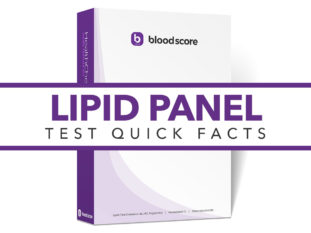Cholesterol Basics: Why does cholesterol matter?
Cholesterol: What’s it all about?
High cholesterol, or hypercholesterolemia, is generally caused by a number of lifestyle and genetic factors. Luckily, with small changes in diet, exercise, and stress patterns, we can make a big impact on our cholesterol balance.
Cholesterol makes up an essential part of the cells in your body, necessary for survival. Yet too much cholesterol can be bad, so it’s crucial to maintain a healthy balance. Cholesterol levels outside of the recommended ranges or beyond optimal balance are associated with heart attacks, strokes, and other heart and vascular (blood vessel) diseases. On the bright side, we can all manage our cholesterol!
Bloodscore identifies which components of your cholesterol are out of balance and helps you find small changes that can get your cholesterol scores to goal levels.
What do I need to know?
There are several different types of cholesterol, but we will focus on the main components of total cholesterol: high-density lipoprotein cholesterol (HDL cholesterol), low-density lipoprotein (LDL cholesterol), and triglycerides. To keep it simple, we think about the main components of cholesterol as the good, the bad, and the ugly. The recommended goals are as follows:
- THE GOOD: HDL cholesterol (high density lipoprotein cholesterol) protects your heart health and has proven life extending effects. Within reason, the higher this score, the better.
- THE BAD: LDL cholesterol (low density lipoprotein cholesterol) increases your risk for heart attack and stroke. The lower this score, the better.
- THE UGLY: Triglycerides are another type of fat found in your bloodstream, as well as a tough indicator of the quality of your daily diet. The lower this score, the better.
So what’s the goal?
National guidelines recommend keeping total cholesterol under 200 mg/dL, yet that number is meaningless if you don’t understand what makes up the total cholesterol score. You already know the basics: you want more of the good (HDL cholesterol) and less of the bad (LDL cholesterol) and ugly (triglycerides)!
Your goal is to keep your HDL cholesterol over 60 mg/dL. Specific recommendations differ for men and women. Men have slightly easier cholesterol goals, with recommendations to keep HDL above 50 mg/dL. Right at or above 60 mg/dL would be more ideal for all males and females (according to National Cholesterol Education Program (NCEP) Adult Treatment Panel III guidelines). LDL cholesterol should remain under 100 mg/dL and triglycerides below 150 mg/dL. Many people need help keeping their levels within these recommended ranges.
Simply put, your goal is to keep the good cholesterol (HDL) above 60 mg/dL, the bad cholesterol (LDL) under 100 mg/dL and the ugly (triglycerides) under 150 mg/dL.
Your goal is to keep our Good (HDL) Cholesterol over 60 mg/dL, Bad (LDL) Cholesterol under 100 mg/dL, and Triglycerides under 150 mg/dL)
Can I really control my cholesterol naturally?
Yes! Most people can control their cholesterol without much effort. Bloodscore helps people figure out where and how to focus that effort, so that a little change goes a long way!
Out of balance cholesterol is associated with an increased risk of developing heart disease-related conditions, such as heart attack and stroke. However, with a few simple lifestyle changes, and possibly natural remedies or over-the-counter supplements, most people can get their cholesterol scores to fall within the recommended levels, reducing their risk of heart disease.
What if my Total Cholesterol is “normal?”
Knowing that your lab scores are within “normal” range is not enough. You should test your blood frequently enough to establish lab score trends. Follow your trends, so that if one of your levels starts to head in the wrong direction, you can make a change before it becomes a problem.
Most health care providers only have time to identify whether or not your lab scores fall within “normal” range. The Bloodscore Insights team produces a trended lab report that you can use to know more about your lab scores and track your progress. Even if you don’t use Bloodscore, we encourage you to know your trends, not just whether your lab scores fall under “normal” or “abnormal.” We aim to provide you with all of the information you need in order to take control of your cholesterol.
Sources:
http://www.mayoclinic.org/diseases-conditions/high-blood-cholesterol/home/ovc-20181871


